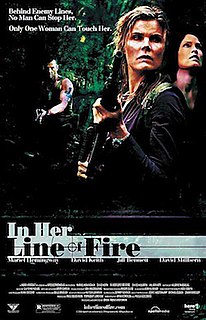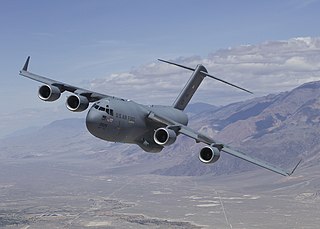
The Boeing C-17 Globemaster III is a large military transport aircraft. It was developed for the United States Air Force (USAF) from the 1980s to the early 1990s by McDonnell Douglas. The C-17 carries forward the name of two previous piston-engined military cargo aircraft, the Douglas C-74 Globemaster and the Douglas C-124 Globemaster II. The C-17 commonly performs tactical and strategic airlift missions, transporting troops and cargo throughout the world; additional roles include medical evacuation and airdrop duties. It was designed to replace the Lockheed C-141 Starlifter, and also fulfill some of the duties of the Lockheed C-5 Galaxy, freeing the C-5 fleet for outsize cargo.
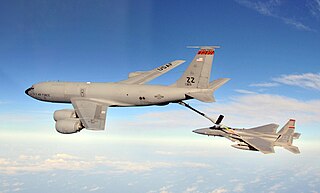
The Boeing KC-135 Stratotanker is a military aerial refueling aircraft. Both the KC-135 and the Boeing 707 airliner were developed from the Boeing 367-80 prototype. It is the predominant variant of the C-135 Stratolifter family of transport aircraft. The KC-135 was the US Air Force's first jet-powered refueling tanker and replaced the KC-97 Stratofreighter. The KC-135 was initially tasked with refueling strategic bombers, but was used extensively in the Vietnam War and later conflicts such as Operation Desert Storm to extend the range and endurance of US tactical fighters and bombers.

The Boeing B-29 Superfortress is a four-engine propeller-driven heavy bomber designed by Boeing, which was flown primarily by the United States during World War II and the Korean War. It was one of the largest aircraft operational during World War II and featured state-of-the-art technology. Including design and production, at over $3 billion it was the single most expensive weapons project in World War II, exceeding the $1.9 billion cost of the Manhattan Project—using the value of dollars in 1945. Innovations introduced included a pressurized cabin, dual-wheeled, tricycle landing gear, and an analog computer-controlled fire-control system directing four remote machine gun turrets that could be operated by a single gunner and a fire-control officer. A manned tail gun installation was semi-remote. The name "Superfortress" continued the pattern Boeing started with its well-known predecessor, the B-17 Flying Fortress. Designed for the high-altitude strategic bomber role, the B-29 also excelled in low-altitude nighttime incendiary bombing missions. One of the B-29's final roles during World War II was carrying out the atomic bomb attacks on Hiroshima and Nagasaki.

The Boeing 707 is a mid-sized, long-range, narrow-body, four-engine jet airliner built by Boeing Commercial Airplanes from 1958 to 1979. Its name is commonly pronounced as "seven oh seven". Versions of the aircraft have a capacity from 140 to 219 passengers and a range of 2,500 to 5,750 nautical miles.

Atlas Air, Inc., a wholly owned subsidiary of Atlas Air Worldwide Holdings, is a cargo airline, passenger charter airline, and aircraft lessor based in Purchase in Harrison, New York. The airline was named after Atlas, a Titan in Greek mythology, who carried the heavens on his shoulders. Their symbol on the plane's tail is a golden man carrying a golden world. With a total combined fleet of 54 Boeing 747 aircraft, Atlas is the world's largest operator of this iconic fleet type. The airline has 2870 employees and operates to 425 destinations in 119 countries.

Air Force One is the official air traffic control call sign for a United States Air Force aircraft carrying the President of the United States. In common parlance the term describes those U.S. Air Force aircraft designed, built, and used to transport the president. The presidential aircraft is a prominent symbol of the American presidency and its power.

An airborne early warning and control (AEW&C) system is an airborne radar picket system designed to detect aircraft, ships and vehicles at long ranges and perform command and control of the battlespace in an air engagement by directing fighter and attack aircraft strikes. AEW&C units are also used to carry out surveillance, including over ground targets and frequently perform C2BM functions similar to an Air Traffic Controller given military command over other forces. When used at altitude, the radar on the aircraft allows the operators to detect and track targets and distinguish between friendly and hostile aircraft much farther away than a similar ground-based radar. Like a ground-based radar, it can be detected by opposing forces, but because of its mobility, it is much less vulnerable to counter-attack.

The Boeing C-40 Clipper is a military version of the Boeing 737-700C airline transport. It is used by both the United States Navy and the United States Air Force, and has been ordered by the United States Marine Corps. The Navy C-40A variant is named "Clipper", whereas the USAF C-40B/C variants are officially unnamed.

The Boeing VC-25 is a military version of the Boeing 747 airliner, modified for presidential transport and operated by the United States Air Force as Air Force One, the call sign of any U.S. Air Force aircraft carrying the President of the United States.
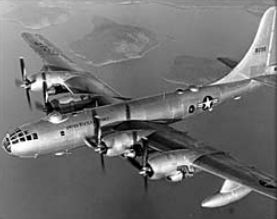
The Boeing B-50 Superfortress is an American strategic bomber. A post–World War II revision of the Boeing B-29 Superfortress, it was fitted with more powerful Pratt & Whitney R-4360 radial engines, stronger structure, a taller tail fin, and other improvements. It was the last piston-engined bomber built by Boeing for the United States Air Force, and was further refined into Boeing's final such design, the B-54. Not as well known as its direct predecessor, the B-50 was in USAF service for nearly 20 years.
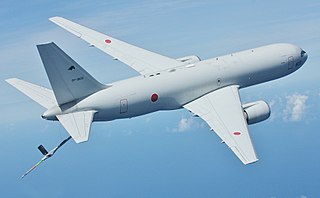
The Boeing KC-767 is a military aerial refueling and strategic transport aircraft developed from the Boeing 767-200ER. The tanker received the designation KC-767A, after being selected by the U.S. Air Force (USAF) initially to replace older KC-135Es. In December 2003, the contract was frozen and later canceled due to corruption allegations.

The Boeing 737 AEW&C is a twin-engine airborne early warning and control aircraft. It is lighter than the 707-based Boeing E-3 Sentry, and mounts a fixed, active electronically scanned array radar antenna instead of a rotating one. It was designed for the Royal Australian Air Force (RAAF) under "Project Wedgetail" and designated E-7A Wedgetail.

The Boeing YC-14 was a twin-engine short take-off and landing (STOL) tactical military transport aircraft. It was Boeing's entrant into the United States Air Force's Advanced Medium STOL Transport (AMST) competition, which aimed to replace the Lockheed C-130 Hercules as the USAF's standard STOL tactical transport. Although both the YC-14 and the competing McDonnell Douglas YC-15 were successful, neither aircraft entered production. The AMST project was ended in 1979 and replaced by the C-X program.

The Boeing 747-8 is a wide-body jet airliner developed by Boeing Commercial Airplanes. It was officially announced in 2005. The 747-8 is the third generation of the 747, with a lengthened fuselage, redesigned wings, new engines, and improved efficiency. The 747-8 is the largest 747 version, the largest commercial aircraft built in the United States, and the longest passenger aircraft in the world.
Air transports for heads of state and government are, in many countries, provided by the air force in specially equipped airliners or business jets. One such aircraft in particular has become part of popular culture: Air Force One, used by the President of the United States and operated by the United States Air Force.

The Boeing C-137 Stratoliner is a VIP transport aircraft derived from the Boeing 707 jet airliner used by the United States Air Force. Other nations also bought both new and used 707s for military service, primarily as VIP or tanker transports. In addition, the 707 served as the basis for several specialized versions, such as the E-3 Sentry AWACS aircraft. The designation C-18 covers several later variants based on the 707-320B/C series. The C-137 should not be confused with the superficially-similar Boeing C-135 Stratolifter; although they share a common ancestor the two aircraft have different fuselages.
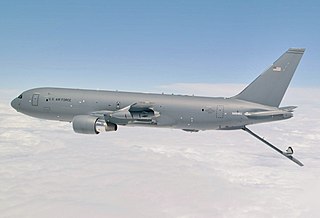
The Boeing KC-46 Pegasus is a military aerial refueling and strategic military transport aircraft developed by Boeing from its 767 jet airliner. In February 2011, the tanker was selected by the United States Air Force (USAF) as the winner in the KC-X tanker competition to replace older Boeing KC-135 Stratotankers. The first aircraft was to be delivered to the Air Force in August 2017, but was delayed until 10 January 2019.
The Boeing 818 was the Boeing's candidate for the U.S. military's TFX fighter competition. The United States Air Force and Navy were both seeking new aircraft when Robert McNamara was appointed U.S. Secretary of Defense in January 1961. The aircraft sought by the two armed services shared the need to carry heavy armament and fuel loads, feature high supersonic speed, twin engines and two seats, and probably use variable geometry wings. On 14 February 1961, McNamara formally directed the services to study the development of a single aircraft that would satisfy both requirements. Early studies indicated that the best option was to base the design on the Air Force requirement, and use a modified version for the Navy. In June 1961, Secretary McNamara ordered the go ahead of Tactical Fighter Experimental (TFX) despite Air Force and Navy efforts to keep their programs separate.


